
Koide Cymbals Process
Our Process
På svenska - klicka här!
Production methods utilize both machine hammering and hand hammering or sometimes both machine and hand hammering combined depending on the models chosen.
Our machine power hammer allows for precise and consistent blows to the bronze blanks and aids in fabrication.
Hand hammering brings variations in impact blows creating uniqueness to each individual cymbal. No automated or computer assisted hammering is used, these cymbals are made by craftsmen.
Today, Koide is a small outfit that values tradition, expertise, quality and places a premium on quality in every regard. Each model of Koide cymbals is produced in small batches to maintain quality control and consistency with a focus on player satisfaction with any given cymbal we produce.
Koide has a wide range of cymbals to suit the needs of professional drummers. From the classic Turkish vibe of the hand hammered B20 703 series to the modern sounding B23 Brilliant series.
Koide Cymbals by design play, sound and feel different from what you may be used to when you first play them. Especially if you use weight as a basis. Sometimes the difference is sublime, and in other cases it can be very different. Koide Cymbals many times can sound like a cymbal that is lighter than the given weight of a Koide Cymbal.
For example, a Koide 20" ride at 2500 grams can have tonal qualities that are found in other traditional cymbals that are several hundred grams lighter or in some cases heaver. This is due to the nature of Koide Cymbal's alloys as with the B21 Absolutes or the B23 Brilliant lines.
By using different ratios of metals, cymbal qualities will be notably different in both feel and sound. As you search through the cymbals on this website, pay more attention to what you hear and don't rely on standard weights, thicknesses or diameter sizes as a reference.
Many variables are at play in a cymbal's sound production. Finding the perfect combination of metal alloy, shaping techniques and knowledge provides the foundation for a truly great cymbal. That is what we are about at Koide Cymbals.
The Koide Cymbals factory and the manufacturing process
The Koide Cymbal Factory is located in Osaka and is the only cymbal maker in the whole of Japan. The Koide Cymbal Factory has cultivated years of experience in metal processing techniques. This has ensured that every Koide Cymbal is made to create the purest and smoothest of tones possible. Each cymbal is full of character and rich in sound.
How a cymbal is made at Koide Cymbals
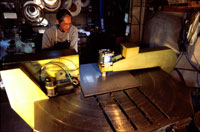
Step 1 – Cutting
Cutting a bronze plate into a circle.

Step 2 – Hole and Cup
Creating the cymbal cup and centre hole. (The size of the cup will vary the sounds of each cymbal.)
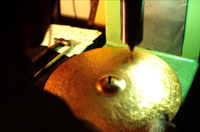
Step 3 – Hammering
The machine hammering processing will give each cymbal a greater expression of sounds.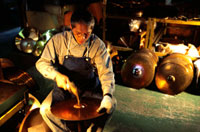
Step 4 – Hand hammering
The hand hammer processing is utilized to tweak and create a greater expression of sounds.
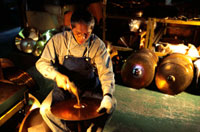
Step 5 – Gauging and Measuring
Each cymbal shape is checked with a gauge. The gauge checking process will ensure whether each cymbal is free from defects including warping and inconsistencies.

Step 6 – Fine Tuning
The hand hammering process is again used to fine-tune the angle and surface of each cymbal to an assigned shape.
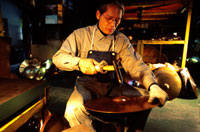
Step 7 – Modifiering
Hand hammering together with continued measuring with a gauge is used in modifying each cymbal’s desired shape and weight.
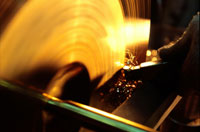
Step 8 – Shaving
Shaving the cymbal surface to create grooves while also creating variations of varied tonal range for each specific cymbal’s sound quality.
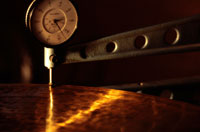
Step 9 – Measuring thickness
Measuring thickness while shaving the cymbal surface.

Step 10 – Continued sound checking
More adjustments are made while the checking process of each cymbal is carried out.

Step 11 – Final quality control
All cymbals at the Koide cymbal factory go through a final and strict quality control process together with a stringent, final sound inspection process. This stage will be unforgiving of any deviations towards the Koide cymbal quality, which is expected in each piece created.
